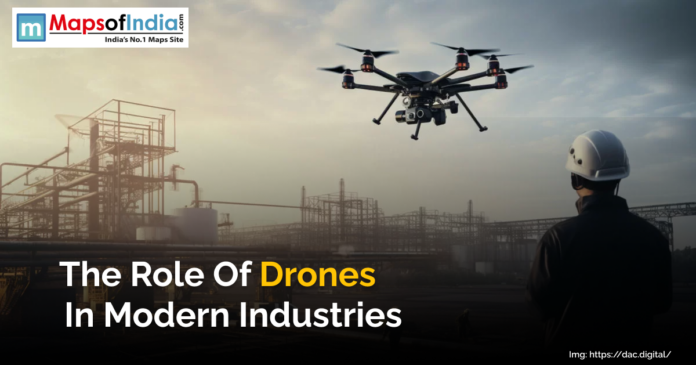From being mainly developed for military purposes, drones or UAVs, have rapidly found a role in different industries. Because they can reach challenging locations, provide live information and get work done quickly, sectors such as farming and disaster services have improved a lot. This blog looks at how drones are involved in many industries, listing their benefits and challenges.
1. Agriculture: Precision Farming and Enhanced Productivity
In agriculture, drones have completely changed the way farmers work. With special cameras, they can check how healthy crops are, find pests, and look at the soil. Farmers can utilize this knowledge to make better decisions, increase yields, and use fertilizer and water more efficiently. Drones, for instance, can pinpoint the precise location of fertilizer or water applications, ensuring that nothing is wasted. Additionally, they greatly simplify and speed up tasks like seeding and pesticide application compared to doing them by hand. Farmers may accomplish more labor, stay safer, and handle fewer dangerous chemicals by utilizing drones.
2. Construction: Site Monitoring and Safety Enhancement
Drone technology greatly improves work in the construction sector in India. Using drones, project managers can view construction sites from above and keep track of how things are moving forward, spot possible hazards and verify that all safety requirements are met. They are able to create in-depth 3D models and maps which support better planning. In addition, drones are used in situations where it would be hard for people to inspect, making these jobs far safer than before. Besides making things safe, this also saves time and reduces the expense of manual inspection.
3. Logistics and Delivery: Revolutionizing Last-Mile Delivery
Using drones, the logistics sector is now able to provide fast and reliable last-mile services. Large companies such as Walmart and Wing are widening their drone delivery options for faster delivery of products to customers. Drones are able to squeeze through busy cities and reach customers quickly, which reduces the time it takes to deliver packages and limits expenses. This proves helpful when getting goods to remote or hard-to-reach places since regular delivery isn’t possible. At the same time, things like following regulations, overseeing air traffic and gaining people’s trust remain to be fixed for most people to use drones.
4. Security and Surveillance: Enhancing Monitoring Capabilities
Drones are especially helpful in security and surveillance. They are able to roam wide areas, oversee perimeters and immediately show what’s happening which helps everyone understand what is happening. Even when it’s dark, drones with thermal imaging can spot any attempt to break in and are therefore very useful for watching over properties during the night. Being able to act fast and deliver live information supports the quick implementation of necessary measures. Besides, drones remove the requirement for watchmen near risky locations, lowering the possibility of harm to people.
5. Emergency Services: Rapid Response and Disaster Management
Drones help during emergencies by quickly giving information about the situation to responders. They may reach locations that ground vehicles cannot and they can transport medical goods, food and important supplies. When dealing with wildfires, drones map the place where the fire is spreading, observe how fast the fire advances and can release fire retardants from the air. Their ability to collect data in real time allows emergency workers to decide what to do, organize help properly and reduce reaction time.
6. Healthcare: Delivering Medical Supplies and Equipment
The use of drones in healthcare makes it easier to send necessary supplies to areas that need them the most. It allows bright to assist in the delivery of blood, vaccines and medicines for fast treatment when necessary. In case of emergency, drones may transport AEDs to those experiencing cardiac arrest and this could help save more lives by cutting response times. This technology is very helpful in areas where regular healthcare deliveries are slow or have many problems.
7. Environmental Conservation: Monitoring and Protection
Environmental conservation relies greatly on the assistance of drones. With the help of drones, researchers can monitor animals, notice their movements and check the habitat without changing the environment. Illegal actions such as poaching and deforestation can be spotted by drones, which gives the authorities reasons to act. Thanks to their coverage of huge areas promptly and the detailed images they take, it becomes simpler to make effective strategies and conservation policies.
8. Energy Sector: Infrastructure Inspection and Maintenance
Besides, drones are used in the energy sector to inspect and maintain power lines, wind turbines and solar panels. By detecting faults, corrosion or damage, they can make sure repairs happen before the equipment fails and less equipment is out of use. If a drone with a thermal camera flies over an electrical system, it can notice any unusual warmth and mark what could be a problem. Drones help to improve safety because they automate inspections and thus reduce the danger for workers at high locations.
9. Media and Entertainment: Capturing Unique Perspectives
Drones have made it easier to shoot movies, news, and shows by giving a cool new way to film from the sky. This means filmmakers and reporters can get better pictures without spending too much money or dealing with too many problems. Drones also help show live events in a more exciting way for the viewers. Since drones are easy to use and reasonably priced, this form of cinematography can now be tried out by many content creators.
10. Challenges and Considerations
Even though drones provide many advantages, using them in different fields causes some challenges. The rules for aviation should keep changing in order to handle problems with airspace, privacy and safety. Another problem is gaining public trust, due to worries about being watched and unsafe data preservation. Battery life, how much the drone can carry and its sensitivity to the weather are things that influence drone operations. Moreover, it is vital to build charging points and service centers for drones to promote long-term growth.
Conclusion
Drones are now a key part of today’s industries because they come up with new ways to make work more efficient, safe and productive. As technology develops and new rules are put in place, drones will have more and more ways they can be used. Using this technology along with managing related challenges will be a key part in guiding the growth of various sectors and discovering new ways forward.





